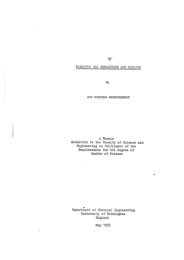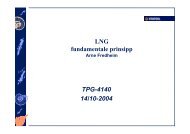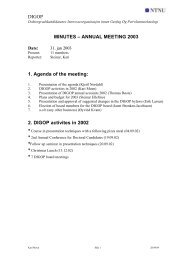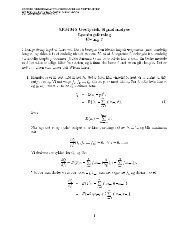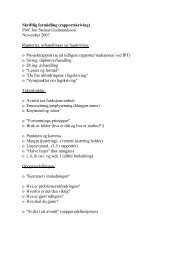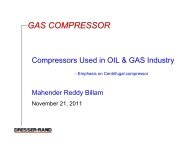Slug Catchers in Natural Gas Production - NTNU
Slug Catchers in Natural Gas Production - NTNU
Slug Catchers in Natural Gas Production - NTNU
Create successful ePaper yourself
Turn your PDF publications into a flip-book with our unique Google optimized e-Paper software.
Karam – <strong>Slug</strong> <strong>Catchers</strong> <strong>in</strong> <strong>Natural</strong> <strong>Gas</strong> <strong>Production</strong><br />
ma<strong>in</strong>ly due to the <strong>in</strong>ability to determ<strong>in</strong>e m<strong>in</strong>utely the velocity and the flow regime under which the<br />
pipe is operat<strong>in</strong>g especially as counter-current flow is frequent and unpredictable <strong>in</strong> mltiphase flow.<br />
The diameter of the f<strong>in</strong>gers is determ<strong>in</strong>ed at a m<strong>in</strong>imum to ensure a stratified flow and then <strong>in</strong>creased<br />
to ma<strong>in</strong>ta<strong>in</strong> the same flow regime at the <strong>in</strong>let of the buffer. Similarily, a downward <strong>in</strong>cl<strong>in</strong>ation of the<br />
f<strong>in</strong>gers ensure a stratified flow.<br />
The dimensions of the slug catcher, based on the method stated <strong>in</strong> this paper, might be larger than<br />
needed. This is due the volume of accumulated liquid assumed to be lower than the calculated volume<br />
as the liquid keeps on be<strong>in</strong>g under the gas bubbles <strong>in</strong> the liquid film dur<strong>in</strong>g production. The<br />
operational liquid holdup used is the one prior to production while <strong>in</strong> reality this value is lower due to<br />
gas pockets and film production. Nevertheless, an overestimation of the slug catcher can be considered<br />
as a safety factor for production. The calculations are also flexible and can be applied to more than one<br />
f<strong>in</strong>ger as long as symmetry is ma<strong>in</strong>ta<strong>in</strong>ed.<br />
HYSYS simulator has been used to generate models reflect<strong>in</strong>g the amount of gas, water and<br />
condensates. The models are not reliable due to the numerous simplifications assumed and the<br />
difficulty <strong>in</strong> simulat<strong>in</strong>g multiphase flow. Multiphase flow is accurately represented by the OLGA<br />
simulator which was not available <strong>in</strong> the HYSYS package I have been us<strong>in</strong>g due to a limited license.<br />
The simplified HTFS homogeneous flow correlation has been used for pipe and well calculations.<br />
Many of the <strong>in</strong>put data were also assumed due to the lack of <strong>in</strong>formation which makes it difficult to<br />
create a model operat<strong>in</strong>g as the real field. The steady state flow is assumed throughout the entire<br />
production.<br />
Ormen Lange model is the most accurate model among the four fields due to the availability of data<br />
and due to symmetry <strong>in</strong> the field design which makes its model<strong>in</strong>g precise. As for the rest, either some<br />
of the ma<strong>in</strong> <strong>in</strong>put data such as the elevation profiles were miss<strong>in</strong>g or the wells are not located<br />
symmetrically or at the same distance from the PLEM. Further assumptions regard<strong>in</strong>g those two<br />
matters made it hard to rely on the HYSYS outcome.<br />
The slug option provided by the HYSYS has shown that some of the results have been affected by the<br />
<strong>in</strong>jection of the MEG and the length of the bubbles as well as that of the slug were reduced. The<br />
amount of MEG <strong>in</strong>jected based on the sheet provided by the Hydrate Eng<strong>in</strong>eer<strong>in</strong>g book was 49 wt%<br />
which is lower than what is currently used <strong>in</strong> the field (~ 60 wt%). This is ma<strong>in</strong>ly due to the <strong>in</strong>puts to<br />
the sheet which are taken from the HYSYS simulator. Furthermore, the volume of water expected to<br />
Page 30 of 56



